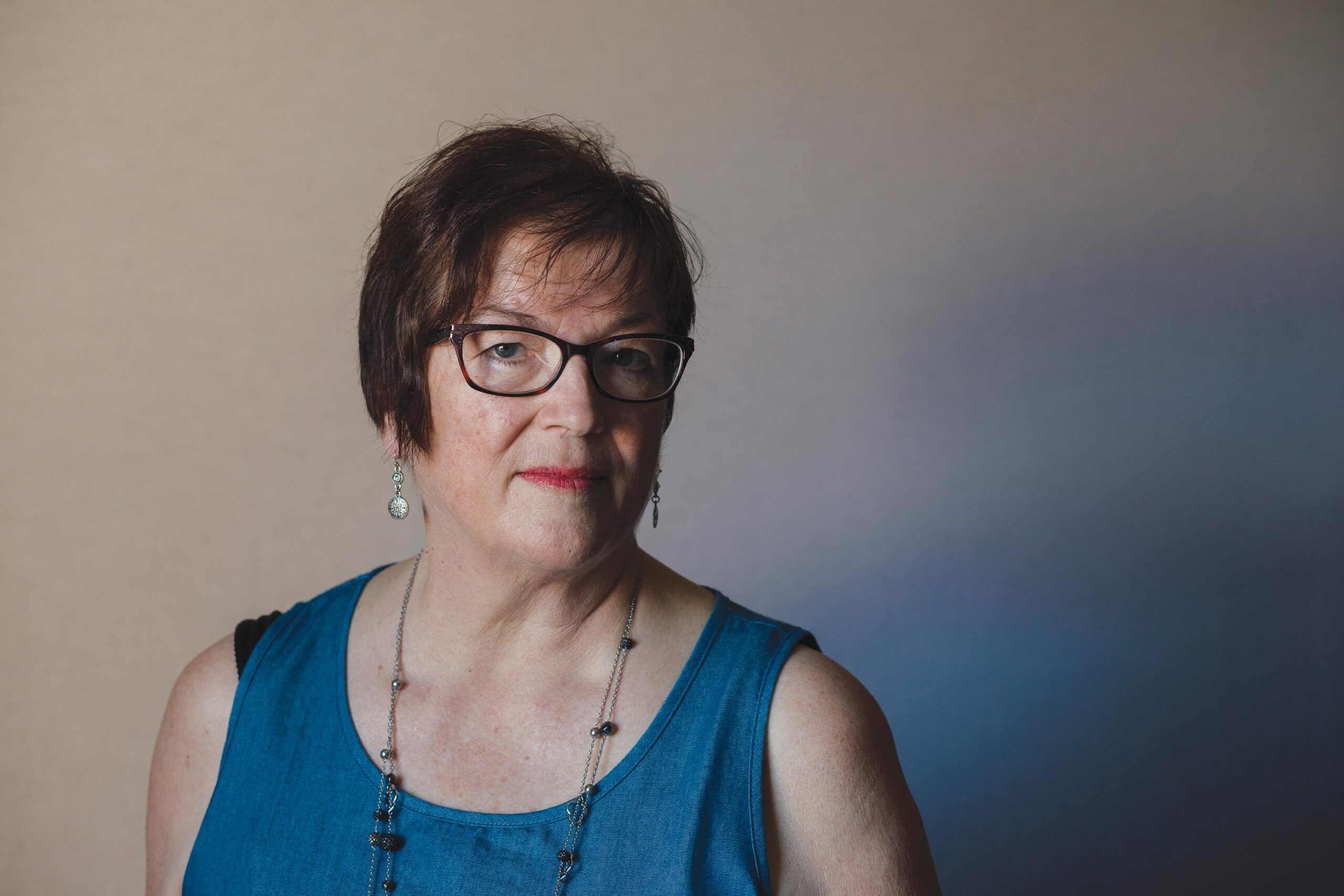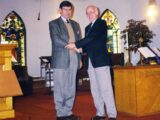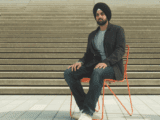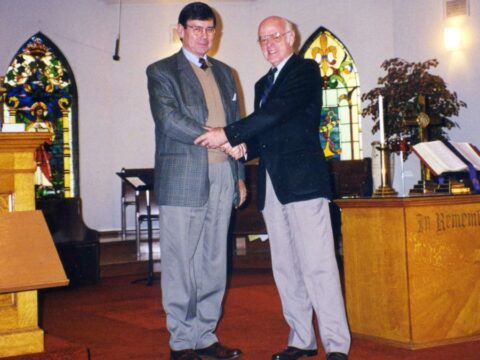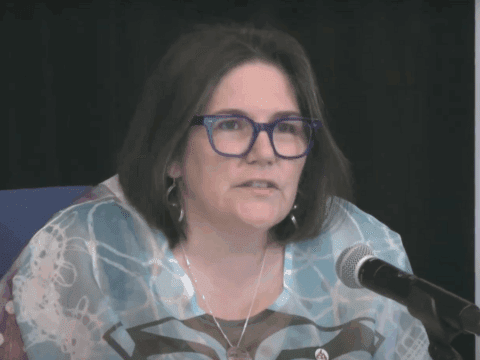CW: This story contains details of sexual assaults and harassment.
Just 10 days after the New York Times published sexual harassment allegations against film magnate Harvey Weinstein, actor Alyssa Milano took to the Twitterverse, encouraging women who had been sexually harassed or assaulted to write “me too,” a phrase originally coined by activist Tarana Burke. By the next day, the #MeToo hashtag had been used 500,000 times, and Facebook had logged more than 12 million posts, comments and reactions.
You may unsubscribe from any of our newsletters at any time.
The avalanche of disclosures and accusations dusted up deep-seated sexual and gender issues and ignited debate. While the controversy storms about what constitutes sexual impropriety and whether public shaming is the best way to handle it, it’s clear that star-studded boardrooms and political chambers don’t have the corner on sexual harassment and violence.
The church is not immune. Meet five United Church women who share their stories of church-related sexual harassment, misconduct and assault, including rape. Some of these stories go back decades; many are being told publicly for the first time. For legal reasons and to honour the wishes of sources, we have withheld one woman’s name and obscured identifying details of most perpetrators.
Eva Stanley
It’s been decades since her piano lessons with the church music director, and Eva Stanley’s memory of that time is sketchy. But she does recall her teacher’s flat black shoes and the ugly way he undid his pants and cleaned himself with a handkerchief during her lessons. She has a sense that he asked her to touch him but isn’t sure. It wasn’t until she got married that Stanley realized that what she had witnessed as a child wasn’t about hygiene. Her naiveté gave way to shock and anger. “I was harmed more mentally than physically,” she says. “The harm actually came so much later because I just thought he was cleaning himself. I had no idea.”
Stanley assumes another child told on the teacher because one day out of the blue her mother asked her if anything strange or funny happened during her lessons. Eva, then about seven, said no. Looking back, she speculates that fear and the instability of her home life led her to deny anything untoward took place. Still, after her conversation with her mother, the music director didn’t teach lessons anymore despite remaining the church organist.
That was Stanley’s first brush with sexual abuse. Later, as a United Church minister in Maple Creek, Sask., she would confront it again. This time, though, she wasn’t on the receiving end. Instead, she found herself ministering to a sexual offender: the chair of her ministry and personnel committee was convicted of voyeurism. Stanley was shocked that the man she was accountable to and had gone out for dinner with could be capable of installing a camera in the women’s change room of the gym he owned.
The church stripped the congregant of his position on the personnel committee. Some members were critical of the way Stanley went to court to support the man’s family, and many didn’t want him to attend worship on Sunday morning. “‘We don’t want a sex offender in the church,’ they said. Which was way different than my experience before [with the organist].”
Stanley says ministering to someone convicted of voyeurism would have been even more challenging if she hadn’t worked through the pain of her childhood experience of sexual abuse. The man and his wife “had come to the church and joined the church, and it was my responsibility as a pastor to be the pastor. So I felt like I had to do that. It felt like a real grown-up thing to do, if that makes any sense. But it was hard. Really hard. . . . It brought back a lot of memories.”

Anjali Persad
Anjali Persad (not her real name) fell in love with her minister. She can’t pinpoint when it moved from a normal clergy-parishioner relationship to an emotionally intimate one, although she remembers being surprised when he put his arm around her waist one day in church. There were also lunches she describes as flirtatious, and one night, a small group from the church decided to meet for a drink. No one but Persad and her minister showed up. She says he pulled the chair close, and they got into a conversation about former U.S. president Bill Clinton and his affair with intern Monica Lewinsky. She says he looked her squarely in the eye and said something like, “I’m ready.”
“I froze. I said nothing. I probably sat there for like a minute, just frozen. Then he broke the silence and made a little joke, and we kind of went on as if he had never said it,” she says. There were hugs and more lunches. Persad told her minister she loved him. She says he told her that he was flattered but that his family was dear to him. Still, the private lunches continued. On Christmas Eve, Persad gave him a book that she knew he had been looking for. She alleges that he kissed her on the lips. Eventually, she grew angry at the situation and drew the line: “No more veiled messages, no more lunches, no more hugs, no more talking to me about your marriage,” she says she told him. “It’s done.”
Looking back, Persad admits that the largely emotional affair felt consensual at the time but that she was vulnerable because she was divorced, had become a single parent and her sister had died by suicide. In crisis, she turned to her minister for support. She says that the onus was on the professional in the situation to draw the boundaries, especially given her emotional state and the power imbalance between minister and congregant.
Despite what happened, Persad remained in the congregation. Years later, she reported the incident to the United Church, who hired an investigator to pursue the sexual misconduct allegations. The minister denied making sexual innuendos and said the kiss was on the cheek. He said he never kissed or touched Persad in a sexual way and never expressed desire for a relationship beyond what they had.
In the end, the investigator concluded that there was no definitive proof on either side to support or refute the allegations. Her report noted that the minister did not demonstrate a clear sense of professional boundaries and recommended further training as a potential way forward.
Persad believes the process failed her. In the course of the investigation that was supposed to be confidential, word got out and she lost the church community she loved. In retrospect, the whole episode broke her trust. “It made me feel used,” she says. “I was supposed to be under his care. Instead of taking care of my needs, he took care of his [emotional] needs with me.”
Now, Persad has moved to a different congregation, where the minister’s professionalism is helping her see the church in a new light: “He is modelling for me the kind of behaviour a minister should have. I’m feeling like slowly but surely with this congregation and this minister, I’m healing some of the trust that was really broken back then.”

Judith Stark
When she first arrived at her new church, Rev. Judith Stark was “chauffeured around a little bit by a board member who mentioned that a fellow in the congregation was ‘very touchy-feely, but just ignore him.’” This was her first clue that sexual harassment was taking place; she would end up spending much of her ministry trying to address it. Sometimes rather creatively.
At special services, the man would sit beside a particular woman and touch her leg, says Stark. “She was very upset about it. She didn’t know what to do. I stuck a lit candelabra with something like 10 or 12 candles right beside her, so there was no way he could get near her without catching on fire.”
Employing a fire strategy to address sexual harassment in a congregation sounds laughable, but it was one of a laundry list of interventions staged by Stark and three levels of church governance. In one incident, her congregant allegedly groped the breast of a staff member while she leaned over the photocopier. Stark also heard stories of sexual advances — kissing, stroking, tickling and innuendo — on women in the congregation she felt were vulnerable. She called the Presbytery for advice.
“They [Presbytery] were flummoxed. So they suggested that I call the Conference sexual abuse committee. They weren’t sure what to do either. There’s a major process for clergy if they dared to do anything like this. What do you do when it’s a lay member?” asks Stark. To muddy the waters, the man was a prominent member of the congregation.
The Conference held a sexual-abuse awareness workshop in the church, and the Conference lawyer suggested moving into a formal hearing. But when Stark raised the idea of a hearing process, one of the alleged victims started to have a panic attack in front of her. Following suit, others were unwilling to face the congregant at a hearing.
A few church leaders confronted the man in a private meeting. He initially denied any inappropriate be-haviour, Stark says, but eventually admitted to crossing physical boundaries with women. He told them he had an unspecified illness and couldn’t help it. Stark took that information to the church board and encouraged them to apply for a restraining order. The day that a restraining order was being discussed, the man notified Stark that he was leaving the congregation.
Still, the Presbytery issued a congregational review and, together with Conference, paid an expert from another province to interview the women. The review found evidence of sexual misconduct against two women in the congregation. One recommendation was to bring in an intentional interim minister to lead the church. Stark had run out of solutions, and the situation had taken a toll. She had started suffering from anxiety attacks; when the chair of the board resigned from the pulpit on a Sunday morning, calling out the congregation for burying the truth and minimizing the harassment, Stark had to lie down to recover.
The congregant returned to the church when the interim minister came, Stark says. “I’ve heard that he has since moved. . . . Who is to say he hasn’t joined another church?”

Meghan Gilholm
If the details of Meghan Gilholm’s rape aren’t shocking enough, the context is. Gilholm says her assault happened at a house party, attended by a number of United Church members. Her alleged rapist is the husband of a United Church minister and a churchgoer himself.
On the night of the party, Gilholm says, the man brought her several drinks. She wonders now if he spiked the drinks, because she remembers lying down on the bathroom floor, aware of her surroundings but too exhausted to move. The timeline is hazy, but she recounts every element of her assault in grim detail.
While she was being raped, she pretended to be passed out. The next day, she told friends that she was so drunk she didn’t remember anything. She chalks up her silence to shock, fear, embarrassment and denial. “I had always convinced myself that he was a good guy who did a really shitty thing one time,” she says. But then the man had a child, and she couldn’t shake the words she says he whispered to her during her assault: “Are you a little girl?”
Gilholm began to tell her story. First in vague terms to friends but then more fully to her sisters and most painfully to her parents. “My dad’s reaction is something I’ll never get out of my head. He looked so angry, so sad and so mortified all at once. Like he couldn’t stop staring at me. . . . My mom was kind of looking down a lot. Finally, she said, ‘That’s really awful, Meghan. I’m so sorry that this happened.’ And I said, ‘Me too.’”
Reliving the suppressed episode sent Gilholm into a constant state of anxiety and panic. Shooting sensations overcame her body, and she was scared to be home alone. She began smoking again and fell behind in her education at the theological school where she was studying for United Church ministry.
Eventually, with the support of a therapist, Gilholm called child services out of concern for the well-being of the man’s child. She also reported the assault to police and wanted to press charges, but without evidence or eye witnesses, the case wasn’t pursued.
Even so, telling her story has been freeing. She says the “disgusting cloud” doesn’t shadow her life anymore. Gilholm is composing music again, which she had unconsciously stopped doing after the alleged rape. She is finishing her studies. Even though charges weren’t laid and Gilholm has heard that the man denies the assault, there’s still a measure of closure: “I know he did it, and I know that he knows he did it. And to me, that’s justice enough.”

Karen Orlandi
At first, Karen Orlandi says, the staffperson at the church where she volunteered stood uncomfortably close. Then he started suddenly appearing behind her in isolated parts of the church, in empty hallways and rooms. She says he began making comments about how beautiful she was, telling her that he and his wife had an open relationship and that his wife was out of town. It felt uncomfortable, Orlandi says, and weird.
At the time, Orlandi was no stranger to wayward sexual comments. She worked in the trucking industry and was regularly on the receiving end of inappropriate remarks. So she’s not sure why it bothered her more when it happened at church. She wonders if it’s because at work she carried the power of management, but as a church volunteer she felt more vulnerable.
One day, Orlandi agreed to a lunch meeting with the man at a restaurant down the road. Over lunch, he asked to see her necklace. She took it off and gave it to him. He started swinging it, Orlandi recalls, and inquiring about her sexual chakras.
She didn’t tell anyone afterwards. But it was the last straw. “I was kind of floored. I really pretty much didn’t go back [to church].”
Back then, she wouldn’t have called what she experienced sexual harassment. “It sounds so silly, but I would never stand for that now. But at that time, it just seemed like I would be making a big deal out of something.” She says she’s a different person now. More self-aware.
As innocuous as the experience seemed then, in hindsight it made a lasting impression on her spiritual life. “I just left the church, and I didn’t go back for a long time,” says Orlandi, now a student at the Winnipeg-based Centre for Christian Studies. “I had such a visceral reaction when I saw him years later, so you know how big an impact it [had]. I kind of went, well no, that wasn’t a small thing.”
If she could turn back the clock and give her younger self advice, Orlandi would break the silence. “I think it would have helped if I had just sat down and talked it over with somebody. Anybody. Anyone.”
4 more women speak out about sexual harassment in the United Church.

The following women have chosen to remain anonymous.
“A member of the church where I worked was inappropriate with preteen girls in the Sunday school. For example, he showed up at the bus stop where one of the girls in the church was waiting and gave her a gift card for La Senza [a lingerie store]. The police said that this man had been banned from other groups like Scouts and the school but that he had never been convicted of an offence. The church assigned people to tail him, but they didn’t feel comfortable doing it. I said I thought he should be welcome at adult-oriented church events but not when children were present because we weren’t able to monitor him properly. I wasn’t throwing him out of the Kingdom, but I didn’t want him around the kids. Parents were beginning to pull their children out of Sunday school. We lost a lot of them. Still, the board didn’t support me, and when my contract came due, they didn’t renew it.”
“When I was 15, a physically intimidating and well-respected man in the congregation asked me to hug and kiss him every Sunday. He used to sit in the pew behind me and made a game of rolling up his bulletin and putting it down the back of my dress. When I stood up for a hymn, he would reach up the bottom of my skirt to fish it out. The people who saw it thought it was cute. I started wearing jeans. My mother told me he didn’t mean anything by it and to brush it off because he was an important member of the community. We moved seats. My mom told me not to wear jeans, but I wore them anyway. That was my small measure of resistance, and I held on to it for years.”
“As a young female minister, I’ve heard all the usual comments: ‘Are you celibate? I sure hope not,’ or ‘I’d go to church more if the priest looked like you.’ But in truth, I find Presbytery and Conference meetings to be particularly difficult. Perhaps it’s because I expect more from my colleagues and church leaders. There are certain men I avoid because it’s uncomfortable having a conversation where they repeatedly comment on my youth and appearance. One mentioned that it’s always a joy to see me because I’m so bouncy. He said this while staring at my chest. I’m certainly not a cheerful person.”
“I was involved in a situation where the Presbytery asked me to provide pastoral support to an office administrator in another church who was being harassed by a congregant. The man started to come in when the administrator was alone. He would ask for hugs and kisses and get angry when she declined. There were excessive emails and calls at home. The blood spattered wide in this case. People who stood up for the administrator became targets. Especially the women on the board and the personnel committee. The chair of the board, who strongly supported this man, told personnel committee members to ‘keep their damn mouths shut.’ He also called my husband and told him to get me ‘under control,’ and he called my colleagues to complain about me. All the administrator was asking was that this man not come into the office when she was there alone. I honestly believe that if they had quietly spoken to him at the beginning, it wouldn’t have escalated. The whole situation was badly handled and disrupted a broad swath of relationships in the congregation that have not recovered.”

The United Church’s response
Alan Hall, the executive officer of ministry and employment at The United Church of Canada, oversees the denomination’s sexual misconduct policy. The following interview, conducted by email, has been edited for length and clarity.
How long has the United Church had a sexual misconduct policy in place?
The policy to respond to allegations of sexual misconduct has been in place for decades now and is continually reviewed and adapted to address concerns identified, no matter what those are. Most recently, the policy was updated last year after an exhaustive review, drawing on the experience of complainants, respondents and investigators, and Presbyteries and Conferences.
How can someone lodge a complaint of sexual harassment or misconduct with the church?
There are a number of ways to bring forward a complaint. If a concern comes to a minister or leader, there should be a referral to a consultant. There is a list of consultants on the United Church website, united-church.ca. We have an information line, 1-800-268-3781, ext. 7788, where a message can be left. There is also an email address, ComplaintResponse@united-church.ca, where inquiries can be sent. If calls or inquiries come in to General Council or to a Conference or Presbytery, a referral would be made to a consultant.
Are all complaints investigated?
Every complaint is investigated. Full stop. Ministry personnel, and now since 2017 congregational designated ministers and licensed lay worship leaders, are required to take boundaries training, with refresher courses every five years. There are training modules available for lay leaders, but these are not yet widely available. We are working on that.
How do our employment practices safeguard churches from predators?
With respect to ministers and leaders in congregations, boundaries training is required; police record checks are required on entry for ministry personnel and now require annual confirmation.
It is up to congregations to decide when police record checks are required for volunteer and employed lay members. Faithful Footsteps and Plan to Protect are recommended resources for congregations.
What if a congregation wants to work with someone who has a criminal history?
We often receive inquiries from congregations who want to hire people with criminal convictions or have them as volunteers. Sometimes these people have completed their sentences, while others may be out on probation or other conditions. When congregations want to work with people who may have (or should have) restrictions, we recommend that they set up a group to whom the person is accountable. That group would work with the person and, if necessary, their parole officer or surety to set up ways for the person either to attend church or to carry out whatever function it is that the congregation wants the person to carry out. References are a critical part of hiring practices as well, so we always encourage those to be done. Congregations and boards need to remember that it’s within their authority to say no to a volunteer and that it’s their responsibility to exercise good and faithful judgment when considering the appropriateness of a person for a position. No rule can legislate this.
How can churches promote safe church culture?
This is an ongoing project. We can have the best policies, but if they are not known or are forgotten, they are of little protection. Education must be done on a regular basis to help people understand what all of this means and how to be well with each other.
How does the United Church’s policy compare to other policies?
Our policy is quite stringent, especially for a dispersed organization that regularly requires employees to work in places where there are no or few other colleagues “in the office” and to minister with people who can be relationally vulnerable. I think we do very well, even though I know that we cannot be totally fail-safe.

